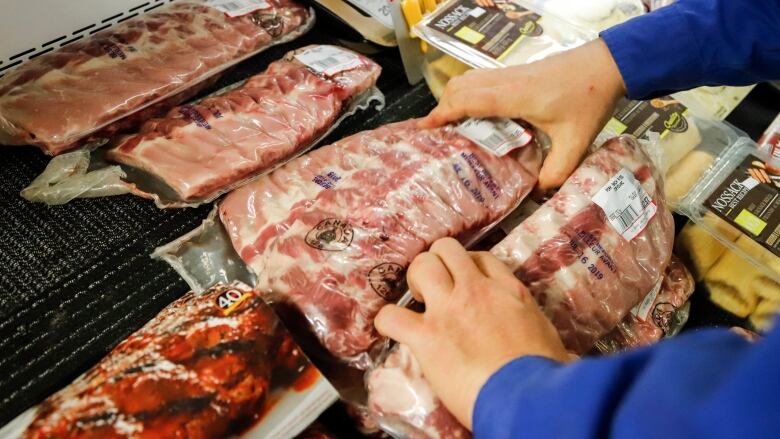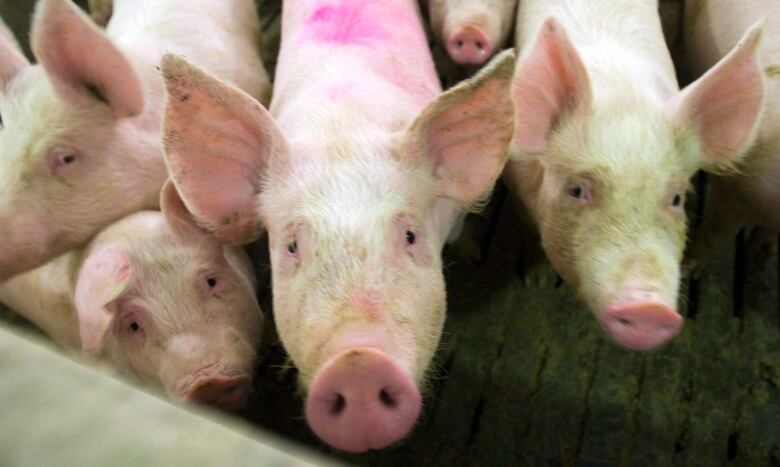Why China has a beef with Canadian meat exports
RCMP,CBSA investigating origins of pork shipment flagged by Chinese inspectors

Canadian officialsareinvestigating after Chinese customs inspectors say they discovered residue from arestricted feed additive in a Canadian shipment of pork products, prompting ahalt of all imports of Canadian meat into the country.
The discovery of ractopamine which is prohibited in China could have a significantimpact on Canadian meat producers. Here's more about ractopamine, its use in Canadaand why it's banned in some countries.
How much beef does Canada export to China?
According to Statistics Canada, in the first four months of2019, Canada exported 7.66 millionkilograms of beef to China. In financial terms, that's about$63.6 million worth of beef and veal.
China is Canada's fifth-largest customer for beef, behind the U.S., Japan, Hong Kong and Mexico, accounting for roughly six per cent of all meat exports.
And pork?
For pork, China was the third-largest export market, behind the U.S. and Japan, with Canadian producers exporting 146 million kilogramsin the first four months of this year.
That's around$310 million worth of porkabout 22per cent of the entire export market.
So why does China have a beef with our meat?
According to Chinese officials,Chinese customs authorities discovered residue of the additive ractopamine in a batch of pork products exported from Canada to China, which has banned the substance.
When Chinese authorities advised Canada of the finding on June 14, it raised a red flag for the Canadian Food Inspection Agency (CFIA), which asked to review the export certificate.

Upon examination, CFIA inspectors confirmed the certificate was inauthentic.
Canada's Agriculture Minister Marie-Claude Bibeautold CBC News that the suspect pork shipments and certificates are unlikely Canadian, but were being misrepresented as such. She also said the RCMP andCanada Border Services Agency are both now investigating.
What is ractopamine?
Ractopamine is part of a larger compound of drugs called beta-adrenergicagonists an animal pharmaceutical product that will speed up an animal'smetabolic rate, said Benjamin Bohrer, with the University of Guelph's department of food science.
Ractopamine is able to more efficiently and effectively synthesize proteins, makinglivestock both larger and leaner much faster.
In 1999, the U.S. Food and Drug Administration (FDA) determined that ractopamine was safe and approved it for use in feed for swine, and later, for turkey and cattle.
Canada generallywill follow suit if theFDA says something is safe, Bohrersaid, and has also approved theadditive for use in the same livestock here.
Why is it banned in China?
The additive is banned in China, as well as in Russia, theEuropean Unionand several other countries. These countries have expressed concernthat the additive poses health risks.
China says it's worried about the higher levels of drug residues that can be found in pig organs, which are part of a traditional Chinese diet, according to a 2013NBC News report.
There have been some reports that the drug adversely affects the health of animals, though the FDA has denied there's a correlation.
Organizations, like the Joint FAO/WHO Expert Committee on Food Additives (JECFA), have recommended a maximum daily intakeof ractopamine. TheEuropean Food Safety Authority, however, has questioned those recommendations and raised concerns about the additive'ssafety.

One of the problems, saidBohrer, is that there are compounds that are unsafe but similar in structure to ractopamine, and that ractopamineunfairlygets lumped in with them.
"They would not be deemed safe for human consumption," Bohrersaid. "That's the challenge with a lot of other countries they don't differentiate between the different family of compounds and they just kind of view them all as having adverse health effects for human consumption. And they don't."
How many Canadian pork farmers use ractopamine?
The irony is that almost no Canadian pork farmers use the additiveontheir livestock,according toGary Stordy,director of government and corporate affairs for the Canadian Pork Council.
"It's really essentially not used in the Canadian industry," he said.
To help ensure that Canadian pork exports do not contain the additive, Canada has established theCanadian Ractopamine-Free Pork Certification Program, whichis overseen by the CFIA. The program is responsible for certifying that pork products exported from Canada originate from pigs that have never been fed and/or exposed to ractopamine.
There may be a very small handful of Canadian pork producerswho use ractopamineontheir livestock and ship to the U.S.,Stordy said. But Canadian producers beganraising pigs without ractopamineabout seven to eight years ago, he said, to penetrate foreign markets that didn't allow the additive to be used.
With files from Kathleen Harris












_(720p).jpg)


 OFFICIAL HD MUSIC VIDEO.jpg)
.jpg)



























































































